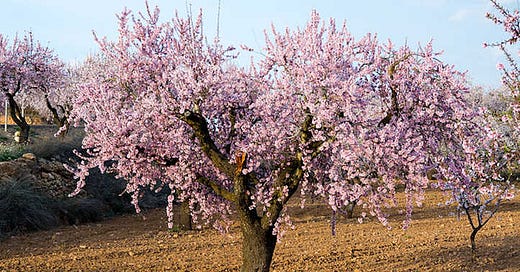Hailed as the New Year for Trees, the festival of Tu Bishvat is marked each year by the ecological awareness of the biblical landscape and a cultural celebration of Israel’s natural environment.
Originally considered a religious and agricultural festival, Tu Bishvat honoured the renewal date for animal tithing by the Jewish farmers, who were commanded to sacrifice their kosher animals at the holy Temple of Jerusalem. In Medieval times the festival was given a deeper spiritual significance, marking the changing of the seasons, the growth and renewal of the fruit bearing trees and the celebration of nature’s circle of life. Typically falling during the late winter months after the often much needed rains, the new year for trees signifies a spiritual connection to the changing seasons and an environmental responsibility to our agricultural heritage.
Tu Bishvat is traditionally upon us when the green countryside of Israel’s lush north is awash with pink almond blossom, one of the early blooming trees that has become symbolic of the onset of the new season of Spring and nature’s rebirth. It is significantly a festival that celebrates and respects our environment, but as with every Jewish holiday, whether religious or cultural, the foods that we eat and the wine that we drink remain symbolic of our ancient biblical traditions and teachings.
It is observed with a ‘Seder Meal’ of foods containing fruits and nuts, and as tradition dictates in the Passover Seder, it is also customary to drink four cups of wine at this Seder by way of celebrating the cyclic nature of the four seasons, using white, rose and full bodied red wines to represent the bleak winter flowing into the emergent spring and finishing off with the ripe, abundant harvest.
The Tu Bishvat celebratory meal was founded during the 16th century in Safed in Ottoman Palestine by Rabbi Yitzchak Luria, also known as A’ari, meaning ‘the lion’ and derived from the acronym ‘Ashkenazi Rabbi Issac’. He became famous within the religious circles for his mystic and spiritual teachings. Together with his disciples, they instituted the seder by means of a symbolic feast to commemorate the seven species, listed in the Bible as “wheat and barley, and vines and fig-trees and pomegranates; olive-trees and honey” Deuteronomy 8:8. Each one represented the agricultural bounty of the ancient land of Israel and were the reputed sacrificial first fruits offered up to the altar in the Temple. Over the centuries, the customary meal has cemented our connection to nature and the spiritual significance to the produce of the land of Israel, undoubtedly influenced by the culinary customs of our heritage.
Every seder includes the ubiquitous braided bread, which must be made from the flour of one of the five grains of wheat, barley, spelt, rye or oats, if it is to be determined a challah in Jewish law. The dough is often embellished on Tu Bishvat with date syrup, raisins and figs, enriching the bread and our connection to the fruits of the land. This is endorsed by the plates of almonds, dates, grapes, dried figs and raisins that are spread across the table for snacking on before, during and after the meal.
The Ashkenazim feast upon the sweet stew known as tzimmes, made from beef, carrots and dried fruits, typically prunes or raisins. Dessert is a compote of a combination of dried apricots, apples, pears and raisins, cooked with honey, cinnamon and a glug of sweet dessert wine. The Sephardim celebrate by preparing a sweet porridge like dessert, made from wheatberries or barley, cooked in water and topped an array of chopped nuts and dried fruits, which is known as ashure or Noah’s pudding. It has long been associated with the early Jewish communities of the Near East and the agricultural rituals of the farmers during the spring wheat harvests and the Mizrachim indulge upon stuffed vegetables and grape leaves filled with a mixture of jewelled rice, heavily laden with sweet fruits and spices. Their meal is often finished with the sweet treat baklava filled with chopped nuts and doused in lashing of honey.
Tu Bishvat is the cultural and spiritual festival that celebrates new beginnings, rebirth and the agricultural growth cycle, which in true Jewish tradition rejoices in feeding our loved ones and feasting on the fruits of the ancient biblical landscape.







